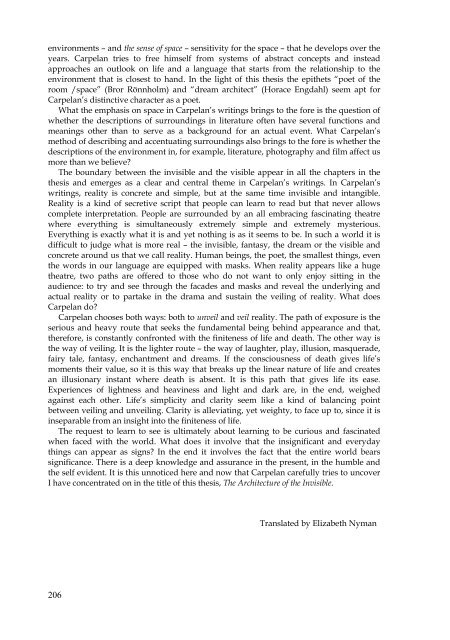You also want an ePaper? Increase the reach of your titles
YUMPU automatically turns print PDFs into web optimized ePapers that Google loves.
environments – and the sense of space – sensitivity for the space – that he develops over the<br />
years. Carpelan tries to free himself from systems of abstract concepts and instead<br />
approaches an outlook on life and a language that starts from the relationship to the<br />
environment that is closest to hand. In the light of this thesis the epithets “poet of the<br />
room /space” (Bror Rönnholm) and “dream architect” (Horace Engdahl) seem apt for<br />
Carpelan’s distinctive character as a poet.<br />
What the emphasis on space in Carpelan’s writings brings to the fore is the question of<br />
whether the descriptions of surroundings in literature often have several functions and<br />
meanings other than to serve as a background for an actual event. What Carpelan’s<br />
method of describing and accentuating surroundings also brings to the fore is whether the<br />
descriptions of the environment in, for example, literature, photography and film affect us<br />
more than we believe?<br />
The boundary between the invisible and the visible appear in all the chapters in the<br />
thesis and emerges as a clear and central theme in Carpelan’s writings. In Carpelan’s<br />
writings, reality is concrete and simple, but at the same time invisible and intangible.<br />
Reality is a kind of secretive script that people can learn to read but that never allows<br />
complete interpretation. People are surrounded by an all embracing fascinating theatre<br />
where everything is simultaneously extremely simple and extremely mysterious.<br />
Everything is exactly what it is and yet nothing is as it seems to be. In such a world it is<br />
difficult to judge what is more real – the invisible, fantasy, the dream or the visible and<br />
concrete around us that we call reality. Human beings, the poet, the smallest things, even<br />
the words in our language are equipped with masks. When reality appears like a huge<br />
theatre, two paths are offered to those who do not want to only enjoy sitting in the<br />
audience: to try and see through the facades and masks and reveal the underlying and<br />
actual reality or to partake in the drama and sustain the veiling of reality. What does<br />
Carpelan do?<br />
Carpelan chooses both ways: both to unveil and veil reality. The path of exposure is the<br />
serious and heavy route that seeks the fundamental being behind appearance and that,<br />
therefore, is constantly confronted with the finiteness of life and death. The other way is<br />
the way of veiling. It is the lighter route – the way of laughter, play, illusion, masquerade,<br />
fairy tale, fantasy, enchantment and dreams. If the consciousness of death gives life’s<br />
moments their value, so it is this way that breaks up the linear nature of life and creates<br />
an illusionary instant where death is absent. It is this path that gives life its ease.<br />
Experiences of lightness and heaviness and light and dark are, in the end, weighed<br />
against each other. Life’s simplicity and clarity seem like a kind of balancing point<br />
between veiling and unveiling. Clarity is alleviating, yet weighty, to face up to, since it is<br />
inseparable from an insight into the finiteness of life.<br />
The request to learn to see is ultimately about learning to be curious and fascinated<br />
when faced with the world. What does it involve that the insignificant and everyday<br />
things can appear as signs? In the end it involves the fact that the entire world bears<br />
significance. There is a deep knowledge and assurance in the present, in the humble and<br />
the self evident. It is this unnoticed here and now that Carpelan carefully tries to uncover<br />
I have concentrated on in the title of this thesis, The Architecture of the Invisible.<br />
206<br />
Translated by Elizabeth Nyman

















